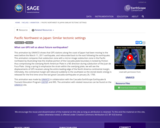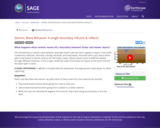
Investigate what GPS can do to help study and predict future earthquakes. [4:12]
- Subject:
- Science
- Material Type:
- Audio/Video
- Provider:
- Incorporated Research Institutions for Seismology (IRIS)
- Date Added:
- 12/01/2023

Investigate what GPS can do to help study and predict future earthquakes. [4:12]

Plate tectonics shift all over Earth. This video illustrates what happened in Pakistan in 2013. [1:59]

A detailed video featuring the challenges of western South America and why it is such a hot spot for earthquakes. [10:16]

Video lecture on divergent, transform, and convergent types of plate boundaries. [1:30]

Learn to define a tectonic or lithospheric plate; differentiate between continental and oceanic plates; differentiate between the 3 types of plate boundaries; and learn about the generalized seismicity associated with boundaries. [6:58]

A short video illustrates how a megathrust earthquake can create a tsunami. Check out the additional resources provided below the video. [1:16]

A brief video illustrates how mid-ocean ridges form new crusts. Understand the process. [1:10]

A time-lapse animation of seafloor spreading and plate tectonic evolution of the planet since 200 million years ago. [0:22]

This animation gives an overview of the most-recognized proponents (and opponents) of Plate Tectonics Theory up into the 1960's, with the discoveries that helped form the theories. [5:56]

Utilize this video to visualize seismicity and volcanic activity in space and time. [1:06]

What do S waves reveal about the Earth's surface? This video will illustrate the research. [2:11]

This introduction to seismic wave behavior describes Snell's Law and how it applies to layers in the earth. It addresses reflected, refracted, critically refracted, and head waves. Seismic waves travel at different speeds through different materials. In this 2-layer model two wave fronts leave an impact at the same time but the lower layer is faster. [2:18]

How are wave paths determined? Which wave paths are the fastest? Find out with the help of this brief video. [0:43]

A brief video will illustrate how a ping announces refracted seismic waves. [0:34]

Studying the travel paths of seismic waves in the interior of the Earth. Find out what the paths look like and why. [1:31]

Video lecture on wave motions and speeds of three fundamental kinds of seismic waves: Primary (P = pressure) waves; Secondary (S = shear); and Surface waves. [3:10]

How do seismologists monitor a situation in New Mexico? Check out this clip illustrating the Socorro Magma Body study. [4:19]

Islands in the south Pacific are recognized for particular features which nurture earthquakes. A video will illustrate tectonic microplates found in the region. [4:09]

Oblique view of a highly generalized animation of a subduction zone where an oceanic plate is subducting beneath a continental plate. [0:27]

Video lecture on four basic types of plate tectonic boundaries: divergent (spreading), transform (strike-slip), and convergent (subduction and continental collision) types of plate boundaries. [2:03]